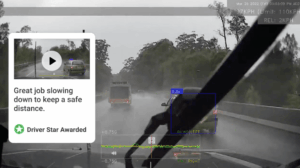Through the summer, Peter Millichap (pictured), Marketing Director at Teletrac Navman UK writes for Highways News on how transport managers can prioritise road safety.
According to the Met Office the upcoming summer months will in fact see an increased chance of heatwaves across the UK, despite the age-old stereotype of wet British weather. As the public welcomes the warm and dry weather that the summer months will provide, it serves as a timely reminder for transport managers to be vigilant of the potential hazards associated with driving in warm weather conditions and safeguard their fleets with precautionary advice and tools.
With challenges such as overheating engines, poor visibility, driver wellbeing and difficult road surfaces, driving in the summer months is by no means an easy feat. In fact, Teletrac Navman’s road safety dashboard, which collects data from the Department for Transport report, highlights that 22% of accidents that occur on dry road surfaces are classified as severe. In 2020 alone, 19,659 accidents occurred in weather typified as ‘fine’, whilst less than 2,900 occurred when the rain poured – highlighting how the majority of accidents occur in average weather, rather than during heavy rain or wind.
These statistics showcase the frequency of road collisions in warm weather and prompt the question: what can transport managers do in the warm and dry months that will help safeguard their drivers and fleets from these key issues?
Here are some tips on how transport operatives can use practical advice, alongside telematics tools, to help support their entire fleet operation overcome the potential challenges of driving in the warm and dry summer months:
- Top up fluids
One of the biggest reasons for vehicle breakdowns in summer is down to engines overheating, so to help to prevent this, transport operators should use maintenance software to ensure their fleets’ fluids are sufficiently topped up. In conjunction, the engine coolant reservoir should be topped up to ensure the entire system keeps cool. If the cooling system is neglected, it can cause wear and corrosion on the engine, eventually leading to long-term damage and breakdowns.
In warm and dry conditions, dust and dead insects also blow onto the windscreen and impact visibility, therefore, it’s key that transport managers have systems in place to ensure their fleets have sufficient windscreen washer.
- Prioritise driver wellbeing
Whilst the wellbeing of drivers is a year-round focus, with the wealth of road collisions that occur during the warm and dry months, it is most certainly worth addressing in the run up to the summer months. By encouraging drivers to keep their vehicles well ventilated and to enjoy plenty of fresh air, not only can transport managers avoid driver drowsiness but they can also alleviate stress and improve the working conditions for their drivers.
Released in April, Teletrac Navman’s new AI-powered dashboard camera – Smart Dashcams – helps transport managers prioritise driver wellbeing and safety. The innovative product rewards driver safety and alertness, as well as providing bespoke guidance tailored to each individual, instilling the importance of driver wellbeing.
- Consider visibility
In the warm and dry months, many drivers will also be dealing with sun glare – a challenge, as the road safety dashboard indicates, that can lead to collisions. In the Summer of 2020 18,994 accidents occurred during daylight hours, of which 22% were classified as severe.
In order to combat this, transport managers should ensure that their drivers have access to essential tools such as polarised sunglasses coated with a chemical filter, which help to cut glare and are an effective tool in helping block the light waves which bounce off horizontal surfaces.
Utilising a vehicle’s sun visor and keeping the windshield and dashboard clear (inside and out) are also helpful and will improve visibility when drivers are on the road. And with Dashcam products available across the telematics market, transport managers can use audio in-cab guidance features to motivate drivers to make these helpful changes.
- Be wary of road surfaces
To avoid road collisions in the warm and dry months, transport managers should remind their drivers to take extra care with steering and braking on difficult road surfaces. If a downpour occurs after warm and dry weather, road surfaces lack grip, due to the layer of oil, rubber, dust and grime that builds up on the road. What’s more with the UK set to face a range of heatwaves, there is a chance that roads may melt due to the intense heat.
When dealing with difficult road surfaces, it is also important that tyres are properly inflated, as under-inflated tyres can overheat and increase the chances of a blowout during summer months. Regular tyre checks are a simple way drivers can prioritise road safety in the dry and warm months.
To help ensure best practices are maintained and driver performance is at its best, an in-cab management system can also be employed to help coach drivers in warm, dry weather conditions. These solutions, such as Teletrac Navman’s Smart Dashcams, can assist with coaching, for example demonstrating when a driver could wear polarised sunglasses or use a vehicle’s sun visor to avoid sun glare. By providing real-time video footage, alongside AI incident detection data and audio in-cab guidance, transport operators can make sure they are prioritising road safety in any weather conditions.
As a global specialist in fleet management software, Teletrac Navman understands how leveraging data can help those in the transport sector improve road safety when faced with the associated dangers of driving in the warm and dry months.
(Picture – Teletrac Navman)






















